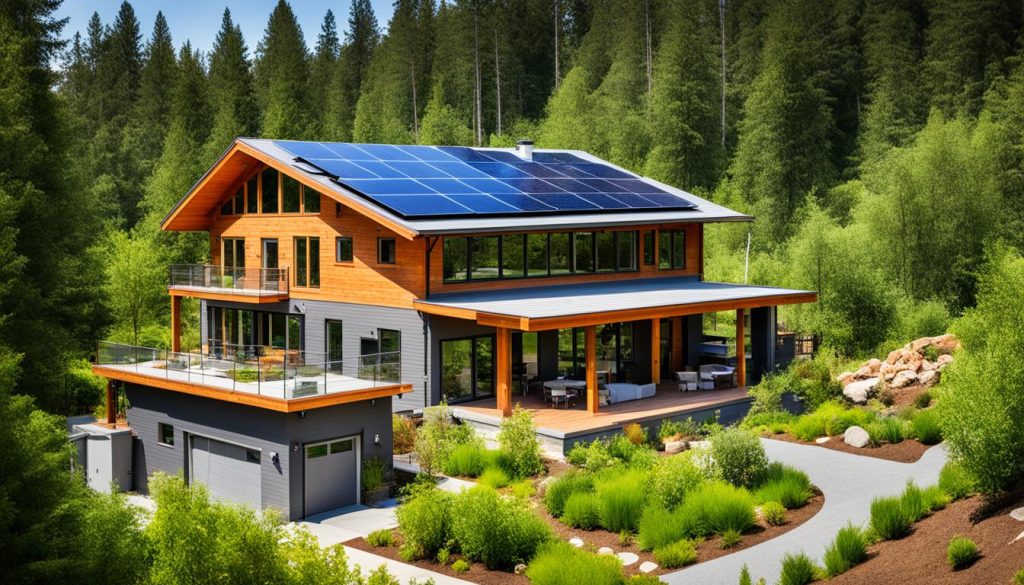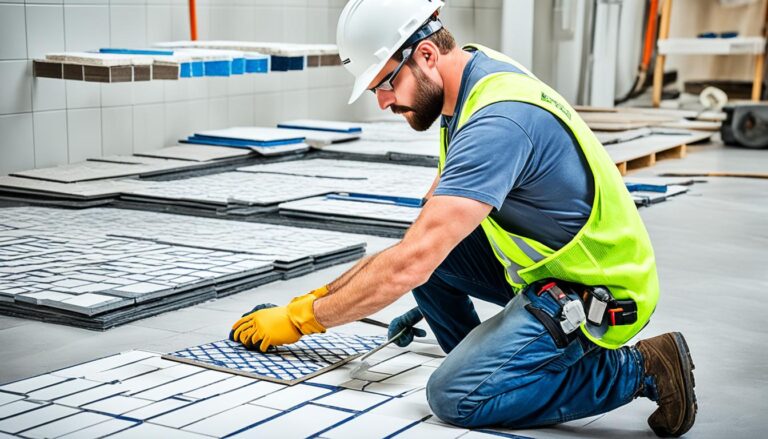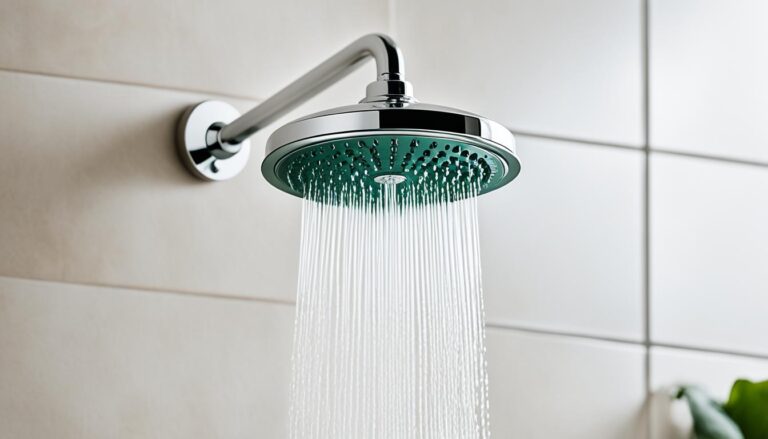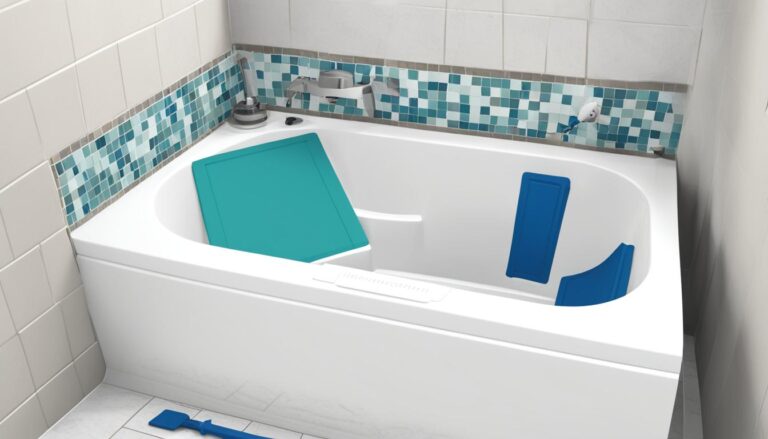Are you trying to make your home more eco-friendly? Do you want to cut down your carbon footprint and save energy? Adopting green building practices is a great strategy. Using sustainable construction methods and energy-efficient designs can make your home a model for green living.
- Green building practices focus on sustainability and energy efficiency in residential construction.
- Implementing eco-friendly construction techniques and using green building materials can minimize environmental impact and reduce energy consumption.
- Green building certification, such as LEED, ensures homes meet rigorous sustainability criteria.
- Green homes offer benefits like lower utility bills, improved indoor air quality, reduced environmental footprint, and increased resale value.
- The future of green building looks promising, with trends shifting towards net-zero energy homes and carbon-neutral buildings.
The Benefits of Green Building Practices
Green building practices help homeowners and the environment. They use sustainable construction methods and energy-efficient materials. This lowers energy use, cuts utility bills, and helps conservation.
1. Energy-efficient buildings
Energy efficiency is key in green building. Homes use less energy and are more sustainable. Energy-efficient appliances, insulation, and lighting cut energy use and utility bills.
2. Sustainable construction methods
These methods reduce environmental impact. They involve proper waste management and water conservation. Sustainable homes save natural resources for the future.
3. Eco-friendly construction techniques
Eco-friendly techniques use green materials and practices. They include recycled or locally sourced materials and reduce waste. Choosing these techniques helps the planet.
4. Green building materials
Green materials, like bamboo and recycled steel, lessen environmental harm. They have a smaller carbon footprint. Using them helps natural resource use.
Green building practices make homes that are efficient and eco-friendly. They save money and protect the environment. These practices improve living spaces and our planet.
Increasing Adoption of Green Building Practices
Recent studies by Dodge Construction Network and NAHB show a rise in green building among builders and remodelers. This move towards sustainable construction marks its importance in the housing market.
The research looked at green trends from 2019 to 2024. Builders and remodelers have been using water-saving ways, choosing sustainable materials, and installing energy-saving systems.
The findings from Dodge Construction Network and NAHB shed light on green building’s progress. Builders and remodelers now see the value of sustainability. It’s good for the environment, their customers, and their profits.
“The findings highlight the positive impact of green building practices on both the environment and the construction industry. It is encouraging to see builders and remodelers embracing eco-conscious practices to create more sustainable and energy-efficient homes.” – [Insert Name], Green Building Expert
Benefits of Green Building Practices
By choosing green building, builders and remodelers enjoy many perks. This approach boosts energy efficiency, lessens the environmental impact, and improves sustainability. Plus, it brings benefits to homeowners and people living in these buildings:
- Lower utility bills due to improved energy efficiency
- Improved indoor air quality through the use of eco-friendly materials
- Reduced environmental footprint by conserving resources
- Potential for higher resale value of green homes
More builders and remodelers going green points to a shift towards better construction ways. They see the lasting gains of integrating green methods, for their clients and for Earth.
| Green Building Products | Builders and Remodelers |
|---|---|
| Energy-efficient windows and doors | 89% |
| Solar panels | 78% |
| Low-flow plumbing fixtures | 72% |
| Recycled building materials | 65% |
| Energy-efficient appliances | 59% |
The table shows the top green products used by builders for better homes. These choices help save energy and lower costs for homeowners.
This rise in green practices shows the industry’s promise to protect our planet. With more builders going green, the home building sector is making a difference for a cleaner future.
Driving Market Demand for Green Homes
Green building is growing, but builders and remodelers worry about recognition. They say the value of green features is often missed in appraisals and listings. This makes it hard to boost market demand for green homes since buyers might not know their benefits.
Yet, there’s good news. Government incentives are making a big difference in promoting green homes. These incentives help builders and remodelers see the value in eco-friendly building. This means homeowners get to enjoy financial perks.
Local, state, and federal governments offer various incentives. These include tax credits, grants, and rebates. These perks help lower the costs of green construction for builders and homeowners alike. Making sustainable homes more affordable.
Government Incentives for Green Building
Here are some examples of government incentives that promote sustainable construction:
- Tax credits for energy-efficient upgrades and installations
- Grants for sustainable building projects
- Rebates for energy-efficient appliances
- Low-interest loans for green home construction or renovation
These incentives don’t just encourage eco-friendly building. They boost the green housing market. By making green homes cheaper, government incentives narrow the gap between sustainable building and market needs.
| Benefits of Government Incentives for Green Homes | Description |
|---|---|
| Financial savings | Homeowners save on energy bills and upkeep costs by going green. |
| Increased property value | Green homes often sell for more and attract those who value the environment. |
| Environmental benefits | Government incentives aid in lowering emissions, saving resources, and protecting nature. |
| Job creation | The rise of the green housing market creates jobs in construction, manufacturing, and renewable energy. |
Government incentives, awareness, and sustainable building’s benefits are key to driving green home demand. They highlight the financial, environmental, and employment benefits. This encourages all involved to support green building for a greener future.
Enhancing Home Resilience with Green Building
Green building can greatly protect your home against nature’s threats. A study by the Dodge Construction Network and the NAHB highlights how builders aim to lessen damages from wind and floods. These are common dangers across the United States.
The study points out the focus on fighting wind and flood effects. In the South, where severe storms hit, builders use green methods to stand up to winds. In the Midwest, known for floods, the aim is on keeping water away.
Green building designs use special measures against wind and floods. This means stronger windows and doors, higher foundations, and better drainage. These steps help keep homes safe from harm caused by wind and floods.
“Green building practices not only create sustainable and energy-efficient homes but also ensure that these homes are better equipped to withstand natural hazards.”
Green building does more than just protect your home. It also makes your community stronger. By using eco-friendly building and flood defense, we lessen the burden on public resources. This helps everyone recover faster after disasters.
“Green building practices foster a culture of resilience, where homes and communities are better prepared to face the challenges posed by natural hazards.”
The push for resilience through green building shows the industry’s commitment to sustainable building. Homeowners gain from this by having homes that are green and more resistant to nature’s unpredictability.
Across the U.S., natural threats vary by region. Green building considers these regional differences. Working with builders who know local dangers ensures homes are ready to face area-specific risks.
In sum, green building is a smart way to boost home resilience. It integrates ways to fight natural dangers like wind and floods. With attention to local differences, green strategies can tackle area-specific challenges in the U.S.
The Role of Green Building Certification
Green building certification is vital for promoting sustainable building. Certifications like LEED set guidelines for environmentally friendly design and building methods. Homeowners can make sure their houses meet tough sustainability standards. This helps create a greener built environment.
Certification programs aim to encourage sustainable building. They define sustainable construction standards for things like energy saving, water use, and choosing materials. These standards focus on making buildings environmentally friendly and energy-efficient.
LEED certification is a top green building certification. It uses a points system to determine the level of certification. Higher levels show greater sustainability achievements. LEED-certified buildings meet strict environmental standards. They use fewer resources and have a smaller environmental impact.
For homeowners, getting certified has many benefits. It means a third party has checked the home meets sustainable building standards. This improves the home’s environmentally friendly design and boosts its market value.
Green building certification offers a blueprint for creating sustainable homes. It covers every step, from design to energy use. Homeowners know their homes reach the highest sustainability standards.
Green certification also pushes homeowners towards environmentally friendly design and building methods. These homes are better for the environment and offer healthier living spaces. They have better air quality, are more energy-efficient, and have a smaller environmental impact.
The Benefits of Green Building Certification:
- Ensures adherence to sustainable construction standards
- Increases the market value of the home
- Promotes healthier living environments with improved indoor air quality
- Reduces the environmental footprint of the home
Getting green building certification shows a commitment to sustainable living. It benefits the homeowners and helps create a greener, more sustainable future. As more people choose green building, demand for sustainable construction grows.
Green Building Materials and Technologies
Green building practices focus on using less energy and being kind to the environment. They combine eco-friendly designs and energy-saving techs. These techniques use sustainable materials and renewable energy. Homeowners can make homes that are good for the planet, cozy, and use less energy.
Using eco-friendly designs is a key part of green building. It means choosing materials that are recycled or from local sources. These choices help cut waste, reduce harmful gases, and encourage the construction field to be more sustainable.
Green building practices ensure that homes are designed and constructed with a focus on environmental responsibility.
Adding energy-saving techs is also vital. These technologies reduce how much energy a home uses. They can lead to big savings on energy costs for homeowners. Examples include solar panels and geothermal heating, which uses the earth’s warmth.
Using renewable energy is another key point in green building. Sources like solar or wind energy can create electricity for homes. Adding these can cut down on using non-renewable energy. This helps make a better future for everyone.
Benefits of Green Building Materials and Technologies:
- Eco-friendly building design promotes sustainability and reduces the carbon footprint of construction.
- Energy-efficient technologies lower energy consumption and utility bills.
- Sustainable materials minimize waste and promote responsible use of resources.
- Renewable energy systems reduce reliance on non-renewable energy sources.
Embracing green building means helping the environment. It also means homes are more energy-efficient, utility bills are lower, and living spaces are better for the planet.
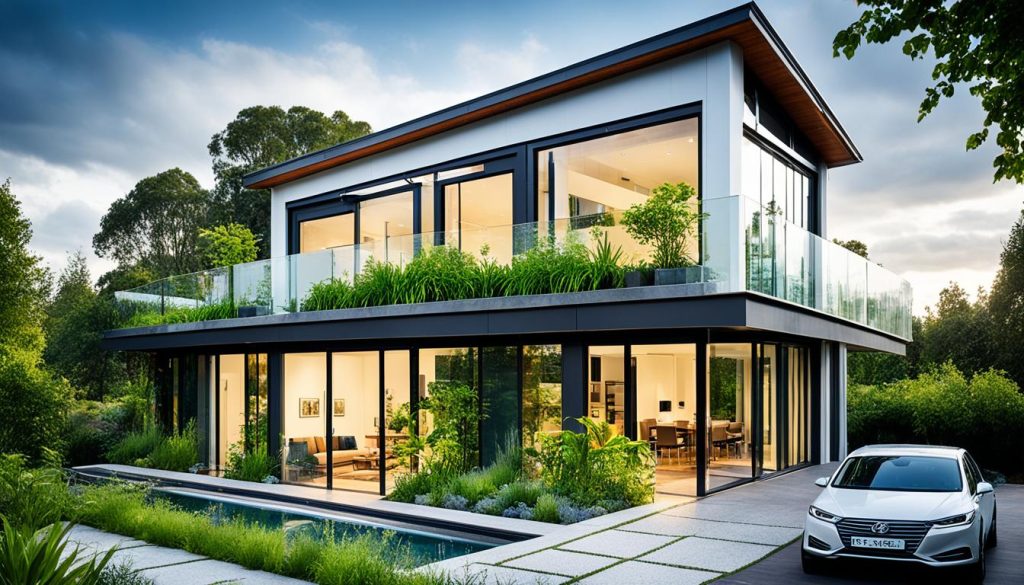
The Future of Green Building
The future of green building is full of potential as we keep moving towards sustainability. A major goal is creating net-zero energy homes. These homes balance how much energy they use with how much they produce. This helps reduce their carbon footprint and saves homeowners a lot on energy costs.
More and more people want to live in homes that are good for the planet and efficient too. This demand encourages the use of green building methods. It also pushes for new advancements in making buildings more sustainable.
In the words of sustainability expert Jane Adams, “By embracing eco-conscious homeownership, we not only reduce our environmental impact but also create healthier and more efficient living environments for ourselves and future generations.”
Another exciting area in sustainable building is carbon-neutral buildings. These buildings aim to have no carbon emissions by using renewable energy and sustainable materials. By doing this, they help fight climate change and make our built environment greener.
Advancements in Sustainable Construction Technologies
We’re going to see big advancements in green building technologies. These improvements will help in many ways like making buildings more energy efficient, reducing waste, and adding smart home features.
- Energy-efficient technologies: Soon, it will be easier and cheaper for people to use advanced energy-saving technologies in their homes. Things like smart thermostats and solar panels will make green homes even better.
- Waste reduction and recycling: Green building will focus more on reducing waste and recycling. Choosing the right materials will lessen environmental harm and increase the use of recycled materials.
- Smart home integration: Green building will include more smart home tech. This tech will make homes more comfortable and help manage energy use better by automating home systems.
Future sustainable construction trends and technologies will lead to more environmentally friendly living spaces. By focusing on sustainability, the future of green building is bright. It promises a healthier and more sustainable world for all of us.
| Trend | Description |
|---|---|
| Net-Zero Energy Homes | Homes that produce as much energy as they consume, minimizing their carbon footprint and energy costs. |
| Eco-Conscious Homeownership | A shift towards environmentally friendly and energy-efficient homes driven by consumer demand. |
| Carbon-Neutral Buildings | Buildings that offset their carbon emissions entirely through the use of renewable energy and other sustainable practices. |
| Advancements in Sustainable Construction Technologies | Innovations in energy-efficient technologies, waste reduction, and smart home integration. |
Green Building Certification Programs
Green building certification programs are crucial for eco-friendly and energy-saving building methods. They set rules and standards that encourage using sustainable materials and designs. Here are some important green building certification programs:
LEED Certification
LEED (Leadership in Energy and Environmental Design) certification is widely known and respected. It is managed by the U.S. Green Building Council. LEED looks at how sustainable a building is. It considers energy use, water use, air quality, and material choice. Buildings with LEED certification show they are built with the environment in mind.
Energy Star Certification
Energy Star certification comes from the U.S. Environmental Protection Agency (EPA). It’s about being energy efficient, mainly in appliances, building design, heating, cooling, and lighting. Homes with Energy Star certification use less energy. This means lower bills and helping the planet.
Green Globes Certification
Green Globes certification is another choice besides LEED. It’s flexible and not too expensive. It looks at many things, like saving energy, water, clean air inside, and caring for the land. The goal is to make building more green without making it hard to get certified.
These programs play a big part in making sure buildings are green and eco-friendly. They help homeowners and builders make choices that are good for the earth. This leads to better design and construction that respects our planet.
Benefits of Green Building for Homeowners
Going green with your home has several perks for homeowners. These benefits include lower utility costs, better air inside the house, smaller impact on the environment, and a bump in how much your home is worth.
Lower Utility Bills
Green homes save money since they use less energy. They have special designs and materials that keep utility bills low. Features like good insulation, energy-saving devices, and smart temperature controls make this possible.
Improved Indoor Air Quality
Green homes focus on keeping the air clean. They use safe materials and make sure the air moves well inside. This reduces dust, harmful chemicals, and other bad stuff in the air. People with breathing issues or allergies will find this especially helpful.
Reduced Environmental Footprint
Green homes are good for the planet. They use less stuff that hurts the environment, like water and energy. They also use materials that are better for our earth. This helps protect our planet for kids in the future.
Increased Resale Value
Green homes are worth more when you sell them. More people want homes that are kind to the earth and cheaper to run. By choosing a green home, you not only help the planet but also could make money in the long run.
Choosing green building is smart. It makes your home better now and a good investment for later.
Conclusion
Green building is becoming more popular in home construction. Builders are using eco-friendly methods and materials. This shift shows people want homes that are good for the planet.
Homeowners see the perks of green homes, like lower bills and cleaner air. This makes the future of eco-friendly construction bright. Green homes can also be worth more when sold.
Eco-friendly building changes how we make homes. Everyone in the industry must support these green practices. This will help make our future more sustainable.

